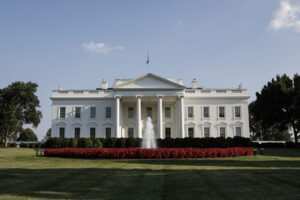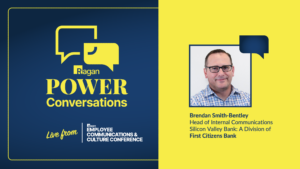11 ways to ensure global townhall success
Establish a clear purpose, craft an agenda, work closely with presenters and IT, and measure metrics afterward.

Two weeks into a new role, I hosted my first companywide meeting.
It was a transformational moment that’s led to my curiosity for innovating and perfecting this pivotal element of employee experience. This article shares lessons I’ve learned from planning All Hands meetings and best practices from peers in internal communications.
Leading townhalls and all-staff gatherings is an incredible honor and a huge responsibility. It takes significant time, resilience and creativity. These recommendations strive to help anyone host an epic experience, whether your team is virtual or in-person.
1. Set a purpose.
“We are gathered here today.” It’s a famous phrase at weddings, but relatable to All Hands meetings as a reminder to elevate the experience to be as memorable as special occasions.
Now, fill in the blank with what your organization hopes All Hands should accomplish. To start the strategic planning, meet with leaders—seek out their perspective and turn this vision into an All Hands mission statement. Bring this concept to a few focus groups of employees at various levels to ensure it aligns with their aspirations. Thousands of hours of employee time is allocated to All Hands—it must be meaningful to them and incorporate their ideas.
Once final, announce your purpose at an All Hands to ensure transparency and accountability. For every presentation, review if it meets the established criteria. For the future, consider an All Hands Advisory Council to hold leaders accountable, offer a sounding board for internal communications and reward employees with a prestigious engagement opportunity. Ultimately, All Hands strives to inspire, connect and inform employees. What is your magic method? Here’s a great approach to thinking about purpose:
“Think of a childhood game of tag. When you needed a rest from the swirling competition, you ran to home base to take a break and prepare for your next move. A team All Hands should leave you feeling the same way: welcome, recharged, and motivated to get back in the game with a renewed sense of purpose. -Sara Glick, Senior Director of Internal Communications and Engagement at US Chamber of Commerce
2. Draft the agenda.
Begin All Hands planning by looking at a calendar. Consider the past, present and future for important and timely topics to address. It’s key to have a window into what leadership and employees have accomplished. Then, it’s time to prioritize. Ask yourself—what’s most exciting, what’s challenging and what’s on everyone’s mind? While it’s tempting to pack every topic into an hour, less is more. Take a deep dive—spending 15 minutes on one topic rather than 5 minutes on multiple topics.
Present your leaders with a suggested agenda and review it with them. For each item, list why you’ve selected it so the goal is clear. Leave room for others to suggest topics, but don’t hesitate to shape the agenda from the top down. Once aligned with leaders, invite presenters to start planning. Create a minute by minute agenda that brings all of the topics together and keeps All Hands on track. Here’s advice on effective planning:
“All Hands are an important touchpoint between employees and leadership and they’re helpful for framing the big picture and keeping teams focused on top priorities. One of the biggest keys to organizing a successful All Hands is planning an agenda that works for the entire audience. This can be challenging, especially when you’re bound by time constraints, but what I’ve found helpful is to seek input from key stakeholders about what’s top of mind for them and their teams. Once you’ve organized this information, you can start to plan around common trends that surface. The more you can connect the dots between agenda topics and the big picture, the more your attendees will be intrigued and engaged by the meeting. -Eric Gonzalez, Internal and Executive Communications Manager at YouTube
3. Practice with the presenters.
Interesting content is only as interesting as its delivery. It’s your role to help presenters approach public speaking with confidence, creativity and impact. Draft a best practices checklist as a resource. Record a video training for presenters to help them craft their narrative. Encourage presenters to carve out time to thoughtfully consider their goals, main objectives and takeaways in advance.
Encourage presenters to weave those core goals into a story. Begin with a hook to capture the audience’s attention. Share several powerful examples. Engage the audience in the presentation. Consult one of my favorite books on this topic—Carmine Gallo’s The Storyteller’s Secret for more tips. Then, encourage employees to draft talking points and slides to match.
Schedule a practice session in advance with enough time or presenter’s to incorporate feedback. Ensure you’ve built trust with presenters so they are receptive to your suggestions. Encourage them to practice on their own. A 10-minute presentation can take ten hours of preparation, but it will be worth every minute invested for the results.
4. Review with leadership.
Along the way, it’s important to keep leadership updated on the planning process. Give them time to review slides before they go live. Different perspectives provide insightful feedback to shape the All Hands experience.
Sometimes, five minutes before All Hands, content might be cut. It’s par for the course of internal communications, just go with it—you’ll just have more time for live questions and answers—which everyone wants anyways.
5. Partner with design and tech.
Without the Design and Tech teams, All Hands couldn’t happen. Design takes ideas and translates them into visuals. Partner with Design to create a template deck with branding and formatting options to empower employees to customize presentations. For special-occasion All Hands, ask the Design Team to review the deck and polish slides for maximum impact.
With the Tech team, ensure the accurate amount of licenses exist for employees tuning in virtually, recording is turned on and audio/visual sounds and looks good. Schedule time to prep in advance and ensure live tech support at All Hands for a smooth experience. Inevitably, something may not run smoothly, so it’s important to have a contingency plan in place because the show must go on! Here’s more wisdom on that topic:
“In this remote/hybrid world, the tools we use are nearly as important as the content. Find an excellent technology partner and, together, treat your internal audience with the same level of importance that your company treats an external audience. Put in time on the front end to practice, rehearse, and make sure you have a back-up to the back-up on the tech front. For every meeting, I put together a “worst-case scenario” messaging doc that includes pre-populated Slack and email messages in the event of a complete tech breakdown. I find that just having the messaging doc open and ready makes me feel prepared for whatever comes my way.” -Brianna Barker, Senior Director, Employee Communications, PBS
6. Timing is everything.
Find the best time for All Hands that works well for as many employees as possible. In our global and remote world, be as time zone friendly as possible. Here’s advice on finding that rhythm:
“At Real Chemistry, we’ve found and been fairly successful with our All Hands by keeping them at the same time (e.g., 12 noon ET on Fridays) so our colleagues can plan/know what to expect.” -Chase Warner, Senior Director, Internal Communications at Real Chemistry
While All Hands is happening, keep everyone on track. Find a system that works well to gently remind presenters that time is almost up. I’m a big fan of soft musical instruments, such as my childhood Xylophone which I found in an old drawer during quarantine time and repurposed as the timekeeper of All Hands! Don’t hesitate to cut people off! Most importantly, begin and end when you say you will.
7. Organize a pre-party.
When I worked in philanthropy, we organized exclusive pre-event receptions for the most committed champions. These gatherings offered access to special content and exclusive conversations with leaders. When applied to All Hands, this philosophy translates well—your employees are the committed champions. If in-person, offer snacks and drinks to sweeten the experience. When remote, request a budget to send employees snack boxes—consider one of my favorites—YumDay which features “unique snacks from emerging women- and BIPOC-led food brands and mission-driven companies.”
For content, consider slides with fun facts about employees, play music composed by employees, celebrate birthdays/anniversaries, play trivia games or screen inspiring company videos. Link this moment to your organization’s culture! When I worked at Spin, I hosted a special segment before All Hands dubbed “Orange You Glad” after the color of our scooters and e-bikes. Shout out to my former colleague Chris Colson for suggesting this award-winning tagline! As a team, we celebrated special moments in employee’s lives. Submitted in advance with quotes, videos and photos, employees were invited to join early to talk about their moment in a minute or less. It made many people smile. I hope you can create your own version of Orange You Glad!
8. Host with heart.
When All Hands opens, greet your employees as guests at a party! Create camaraderie and connection by asking an opening question for everyone to answer in the group chat or comments. The host exudes enthusiasm, curiosity and empathy for the topics covered at All Hands, leading employees through the presentations, connecting them to each other and keeping the momentum. Your leaders can be empowered to host or invite a rotating guest-list of employees who can showcase their talents in creative ways. It’s most important to know the vibe of the meeting and ensure you’re hosting with heart:
“Another important consideration is to try and strike a balance with the tone of the meeting. While it’s great to celebrate team wins and new product launches, you shouldn’t overlook the challenges or areas where teams are working hard to solve complex issues. This is helpful because it shows awareness and empathy, while inspiring teams to think collaboratively about a common path toward success.” -Eric Gonzalez, Internal and Executive Communications Manager at YouTube
9. Celebrate culture and values.
All Hands offers a collective bonding experience to celebrate an organization’s culture and values in creative ways. Make space on the agenda to recognize the stories of employees, your organization’s impact or get to know leaders in a fun way. This segment can be short and impactful, but must be consistent to create conversations and connection.
“At the end of the day – we strive to make our Town Halls relevant and connected to our employees day to day work, but infusing a little bit of humor and fun along the way…occasionally having some “surprise and delight” moments in the form of fun crowd-sourced karaoke videos, new program/benefits announcements, etc. We also have a very active Zoom chat, something we encourage! [It’s] a chance for people to sit back, enjoy some virtual camaraderie, and feel a little more connected during a time of fewer in person interactions.” -Chase Warner, Senior Director, Internal Communications at Real Chemistry
10. Make time for live Q&A with audience engagement.
Live Q&A tops every employee request list for All Hands. Invite employees to submit questions in advance. Ensure there’s time for live questions to address what’s top of mind for employees. Prepare your leaders in advance with potential questions and empower them to talk directly to the team. In addition, offer opportunities for engagement from employees. All Hands should be an active experience by asking employees to participate by sharing their reactions, questions and comments live in chat or with emojis! Here’s more advice on this topic:
“I’m increasingly appreciating Slack as a critical All Hands companion tool, allowing everyone to engage and participate in an event in real-time. One best practice I’m starting to see is for the event organizers to tee up engaging Slack messages that are ready to post at key moments during the All Hands so people can participate in the meeting as we go, via thread replies, emojis or even Slack polls. Beyond engagement, in-meeting Slack posts can be an invaluable source of feedback, illustrating how elements of the meeting land with staff and helping us optimize the content for future meetings, too.” -Diane Bisgeier Tate, Tech Communications Professional
11. Follow up, and measure impact.
After All Hands, share key takeaways and highlights. This should be a best practice after any meeting. It’s a way to reiterate what was covered and share critical next steps.
All Hands should always be evaluated to measure impact. Try live polling tools to ask for instant feedback when an All Hands ends. Consider asking questions about All Hands as part of a Pulse Survey. Host focus groups to always listen for employee feedback. Each All Hands is an opportunity to try something new and different! I can’t wait to hear about the results of your All Hands planning.
Julia Levy is the editor of The Switchboard, an internal communications newsletter and blog that features career profiles and best practices on the field. It is one of her side project passions, which also includes National Muffin Day and Tradition Kitchens. By day, Julia builds communities and creates content in internal communications. Previously, she worked in philanthropy.






